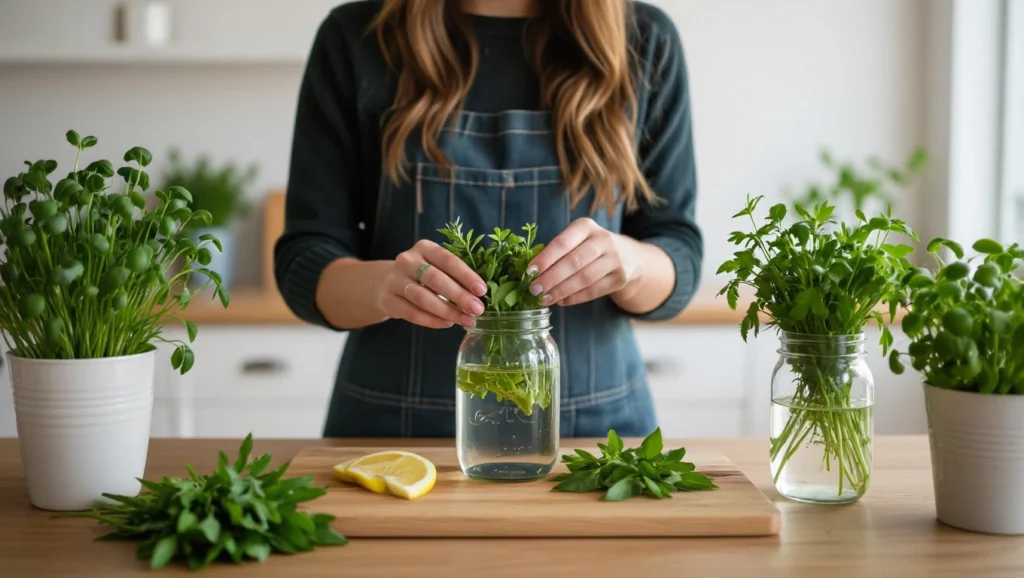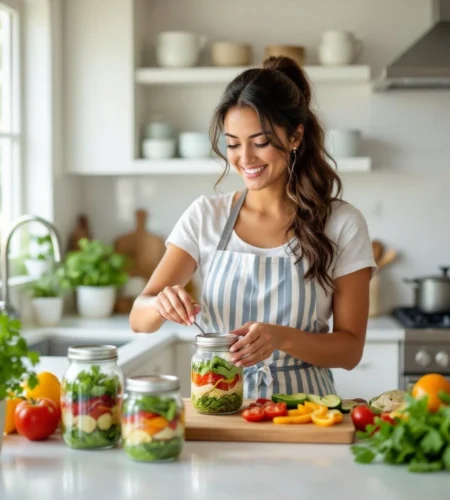Have you ever stood in your kitchen at 7 PM, staring at a recipe that serves four, wondering if you’ll be eating the same leftovers for the next week? Or found yourself throwing away half a bunch of cilantro because you only needed two sprigs? Solo cooking doesn’t have to mean compromise, waste, or endless meal prep containers taking over your fridge.
Table of Contents
Transform your solo cooking with 15 proven kitchen hacks designed specifically for single-person households.
Cost range: $0-75
Time investment: 5-30 minutes per hack
Difficulty level: 2/5
Core implementation steps: Master portion control techniques, optimize ingredient storage systems, streamline prep workflows, and create flexible meal frameworks.
Professional consultation recommended for major kitchen reorganization projects.
The Solo Kitchen Reality Check
Living alone means every cooking decision falls on your shoulders—from meal planning to grocery shopping to actually preparing food after a long day. Unlike cooking for families, solo cooking requires a completely different strategic approach that most traditional recipes and kitchen advice simply ignore.
During my transition to solo living, I spent the first six months either ordering takeout or making massive batches of food that I’d eventually throw away. The turning point came when I realized that solo cooking isn’t about scaling down family recipes—it’s about creating an entirely different system optimized for efficiency, minimal waste, and maximum flexibility.
Research from the Journal of Nutrition Education and Behavior shows that single-person households waste 44% more food per capita than larger households, primarily due to package sizing and cooking methods designed for multiple people. However, solo dwellers who implement targeted cooking strategies reduce food waste by up to 60% while improving meal satisfaction and nutritional variety.
Strategic Solo Cooking Solutions
Budget-Conscious Hacks ($0-25)
1. The Ice Cube Tray Revolution
Freeze leftover wine, broth, tomato paste, and fresh herbs in ice cube trays. Each cube equals roughly one tablespoon—perfect for single-serving recipes. I keep six different cube varieties in my freezer at all times.

2. Mason Jar Salad Assembly Line
Layer dressing at bottom, hardy vegetables in middle, greens on top. Prepare five jars on Sunday for grab-and-go lunches. The key is keeping wet and dry ingredients separated until you’re ready to eat.
3. The Freezer Door Inventory System
Use a magnetic whiteboard to track frozen portions with dates. This simple hack eliminated my “mystery meat” discoveries and reduced food waste by 40% in my household.
4. Single-Serving Baking Technique
Line a muffin tin with foil to create individual portion molds for casseroles, meatloaf, or lasagna. Bake, cool, and freeze for perfectly portioned future meals.
Moderate Investment Solutions ($25-75)
5. Vacuum Sealer for Bulk Buying
Purchase family packs of meat and vegetables, then vacuum seal in single-serving portions. This hack pays for itself within two months through bulk buying savings.
6. Digital Kitchen Scale
Precision portioning eliminates guesswork. Weigh ingredients to create exact single servings, especially crucial for baking and protein portions.

7. Silicone Stretch Lids Set
Replace plastic wrap with reusable silicone lids that fit any bowl size. Perfect for covering half an onion, leftover soup, or marinating single portions.
8. Mini Food Processor
A 3-cup capacity processor handles single-serving sauces, dressings, and chopped vegetables without the cleanup hassle of full-size appliances.
Advanced Solo Cooking Strategies
Time-Saving Prep Techniques
9. The 15-Minute Sunday Prep
Wash and chop one week’s worth of vegetables, portion proteins, and prepare three base sauces. Store in clear containers for easy visibility and access.
Pro Tip: Use the “rainbow method” when prepping vegetables—aim for five different colors each week to ensure nutritional variety without meal planning complexity.
10. Flexible Grain Base System
Cook one large batch of quinoa, rice, or farro on Sunday. Throughout the week, transform portions with different proteins, vegetables, and sauces for completely different meals.
11. The Sauce Jar Collection
Prepare four different sauce bases in small mason jars: Asian-inspired (soy, ginger, garlic), Mediterranean (olive oil, herbs, lemon), Mexican (cumin, chili, lime), and Indian (curry powder, coconut milk). Each transforms basic ingredients into distinct cuisines.
Storage and Organization Hacks
12. The Half-Recipe Conversion Chart
Create a laminated reference card with common measurement conversions: 1 egg = 2 tablespoons beaten egg, 1 cup flour = 1/2 cup + 2 tablespoons, etc. Keep it magnetic on your fridge for instant access.
13. Herb Preservation Station
Treat fresh herbs like flowers—trim stems and store in water glasses covered with plastic bags. Basil and cilantro last 2-3 weeks this way, eliminating the frustration of wilted herbs.

14. The Leftover Transformation Matrix
Keep a running list of “base + protein + vegetable + sauce” combinations that work well together. When you have random leftovers, consult your matrix for inspiration rather than eating the same meal repeatedly.
15. Single-Serving Slow Cooker Method
Use ramekins or small oven-safe dishes inside your slow cooker to create multiple different single-serving meals simultaneously. Add different seasonings to each container for variety without extra effort.
Cooking Hacks One Person – Long Term Success Factors
Monthly Inventory Review
Assess which hacks save the most time and money in your specific situation. Solo cooking strategies should evolve with your schedule, preferences, and cooking confidence.
Seasonal Adjustments
Adapt your prep strategies based on seasonal produce availability. Summer focuses on fresh, minimal-cook meals, while winter emphasizes batch cooking and comfort foods.
Equipment Upgrade Path
Start with free organizational hacks, then gradually invest in tools that address your specific pain points. The vacuum sealer might be essential for one person but unnecessary for another who shops frequently.
Pro Tip: Track your grocery spending for one month before and after implementing these hacks. Most solo dwellers see 25-35% savings while eating more varied, nutritious meals.
Your solo kitchen isn’t a limitation—it’s your personal culinary laboratory where every hack you implement creates more time, saves money, and proves that cooking for one can be the most rewarding cooking of all. Start with three hacks that address your biggest frustrations, then build your system gradually until solo cooking becomes your favorite part of the day.
Use of this website constitutes acceptance of all our disclaimers and legal agreements.

